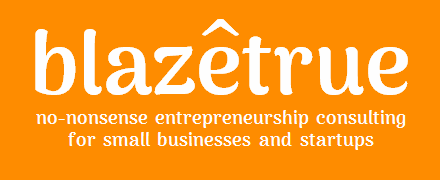



Prince Peter 25th May 2025 updated.
Most businesses fail.
Understand that as a fact, and think about that for a few seconds, before reading on. Most businesses fail.
Studies and reports across several decades show that the bulk of all business ventures, specifically small businesses, will fail within a few years of starting up. Numbers vary about the exact extent of entrepreneurship failure - they range from 66-90% - but it can be agreed that the vast majority of all businesses fail within their first 10 years.
Which means that, if you take the path of a typical entrepreneur and do what most business owners do, then it is highly likely that your startup or small business too will fail. That's a scary thought.
What are the main reasons that so many businesses fail? Is there any way that you, as an entrepreneur, can prevent your venture from failing? Let's try to discover the surprising answers to all those questions.
This Blazetrue article too is aimed at my core audience of independent startup and small business entrepreneurs.

Without any question, the most prevalent cause of business failure and the worst way of failing in business, is when the entrepreneur never starts up.
He has an idea, she has a plan and then - nothing! They might talk about it to some friends, get enthusiastic about it at times, even criticize others who start similar businesses and - do nothing.
Sadly, this is by far the commonest way to fail as an entrepreneur. And these failures are not even tabulated in the statistical calculations of 66-90% failure!
This failure is so sad that it does not even count as failure. Because to fail, to really fail, you have to try, to attempt, to risk, to do. The deep desire to try to make a difference is so intrinsic to what it means to be an entrepreneur that the non-starter totally misses the mark.
The non-starters may give themselves many reasons - the time was not right, others did it before we could, the environment was unsupportive; but the end result is always the same. Stillborn dreams.
Simple truth: You cannot finish unless you start and you cannot start unless you start.
One of life's greatest risks is never daring to risk.
Oprah Winfrey
In all Blazetrue articles, including each of the sections in this article, you will find real-world examples to illustrate an idea. But this type of business failure has no famous examples because you cannot be counted when you don't even show up.
Perhaps you know some real-life examples? Perhaps you have heard them perpetually talking about ambitious business ideas - from the safety of their chair or keyboard? In your workplace, in parties, in pubs and tea-stalls? Those are the only examples I can offer for now.
The solution is so very simple: Just Give It A Try.
No, you don't have to take out a loan or mortgage your house to roll out your entire, 60-page business plan. Minimize your risks and implement the smallest scale version that your business idea allows.
Make one cake. Do one delivery. Offer services/goods to one customer. Create one basic solution, and deliver to one neighborhood or one building or one person.
Call it whatever you want - trial or test-marketing or proof of concept or whatever; but do it - and do it with passion and seriousness.
Once you have implemented this micro-version of your business, you will have taken that first step towards being an entrepreneur.
You will also have a basic proof of your concept. Or not. If not, you can analyze what went wrong and improve - or drop the idea and start with the next.
Yes! That's all there is to it! So, go on.. think, plan and take that first baby step, because even the biggest businesses can start very, very small.
The journey of a thousand miles begins with a single step.
Lao Tzu
Karsanbhai Patel started very small. In 1969, he implemented the smallest scale version of his business idea.
Since he was starting with almost no capital, Karsanbhai worked alone in the backyard of his house in Gujarat, India and began manufacturing low-cost detergent powder.
Since his only source of income was his full-time job as a state government employee, he sold the detergent along the 15 kilometres bicycle ride to and from his office.
Since he had a zero marketing budget, he did all the packaging and branding himself, and backed his product with a money back guarantee.
Since he had no retail chain backup - and also because he recognized the huge market gap - Patel priced his detergent powder at just ₹ 3 per kilo, less than one-fourth the price of Surf, the market leader, which was priced at ₹ 13 per kilo!
Karsanbhai started off by selling nearly a dozen packets of his home-made washing powder per day - great pocket money!
He kept at it. Karsanbhai left his job 3 years later to concentrate full time on his growing venture. And kept at it. He realized that he had effectively created an entire, new market segment. And kept at it.
Karsanbhai kept at it and by 1985 something unbelievable had happened.
In a business dominated by global giants such as Unilever and Procter & Gamble, this one-man, part-time, zero-budget, bicycle-sales startup had become India's leading detergent powder!
Nirma had achieved recognition as one of the best known consumer brands in the country, and soon forayed into soaps and other personal care products where it continued its success.
With great entrepreneurial zeal and a willingness to upend conventional business thinking, Patel expanded and grew Nirma into a multi-product, multi-segment giant with sales of over ₹ 7,000 crores and over 18,000 employees.
Karsanbhai Patel had started small, with a bicycle.
Don't you have more than a bicycle and zero budget? So, what's stopping you?
What if you still cannot do it? Or, what if after trying it, you feel that you did not enjoy doing it?
Then, maybe you will know that entrepreneurship is not for you. That perhaps, you have - or need - other dreams. That's a great result too.
But reading this, right now, and later thinking about it alone, if you feel that your idea, your vision of entrepreneurship does not quieten down, then don't wait too long.
Give the smallest scale version a try. It's easy.
At any rate, it is far easier than knowing for the rest of your life that you didn't even try.

The fundamental, most common cause, of business failure is that the entrepreneur does not offer the belief and care that is needed to sustain and nurture the business.
Many people think it is bad planning, cash crunch, competition, government regulations, lack of money, bad market etc. that causes businesses to fail. Sure, those reasons may sometimes contribute to a business shutdown, but the primary reason is lack of belief.
Without enough belief the business becomes a tottering edifice, destined to crash, any day. The other external factors, that are quoted as reasons of failure, are simply random gusts of wind that got stuck with the blame.
Most of the small business failures I have witnessed were self-fails by entrepreneur owners who consistently failed to believe in their enterprise or started caring (and worrying) about the business far too late.
Some of these entrepreneurs had 5-6 other priorities - and at failure still wondered "why did my business fail?" The answer is that the businesses did not fail - the entrepreneurs did. The best business idea backed by a booming market cannot survive an uncaring or unbelieving entrepreneur - and does not.
This type of business failure is not limited to small businesses or cash-strapped entrepreneurs; some of the biggest failures of belief are by businesses with huge resources and incredible opportunities.
One person with a belief is equal to ninety-nine who have only interests.
John Stuart Mill
Google's social media catastrophe is a direct result of non-belief.
Orkut, a Google company, was founded in 2004, a full month before Facebook. It spread globally and was the leading social network in India and Brazil - two of the fastest growing economies in the world.
Orkut could have been a world leader, but Google failed it. First, by not believing in and valuing social networks enough (Why, why are you in a segment if you don't even believe in its fundamental concepts?!). And then when it woke up to the giant Facebook at the door, Google failed Orkut yet again - by abandoning it and trying other options instead of believing in, and nurturing, Orkut.
Though it still managed to retain its leadership in some markets, without meaningful support from the parent Google, Orkut died a slow, painful death.
Jaiku, a 140 character limit messaging service, very similar to Twitter was bought by Google in 2007. Despite actually growing faster than Twitter, and being within 37% of Twitter's user base, Jaiku too died in 2012 of neglect and lack of belief from Google. See a pattern yet?
In 2009, Google introduced Wave, a fascinating concept involving digital collaboration and social networking. And Google pulled the plug on this baby an unconscionable 77 days after opening it to the public. 77 days?! Come on, teen crushes last longer than that!
Google+, the company's most ambitious social media venture till date, arrived in June 2011. Google was banking on it to be their social media win. But, though they probably never realized it, it was already too late for Google.
Google+ was an acknowledged failure almost from the beginning. Not because it did not have good features (it had many) or lacked users (it had over 300 million).
Google+ failed because the social media market had finally given up on Google - just as Google had consistently given up on its social media products. The millions of people who repeatedly signed up and invested their trust and time in Google's unbelieving ventures had, at last, had enough.
In effect, what Google had done across a decade was to spend billions of dollars to convince billions of actual and potential users that any social media venture by the company was suspect and liable to be abandoned at any time. So, users could not commit to its social media ventures and use it their first-choice, long-term option, the exact opposite of what a social media leader needs.
The market had finally understood what Google had been saying all along through their actions - We don't believe in our own social media products, why do you?
Postscript: Till date, Google's greatest social media success has been YouTube, a medium which Google did not even categorize as social media. It is just as well they did not!
Do this.
Commit to how much you will believe in your venture by asking yourself how important the business is to you and how much you expect the business to offer you. Then commit to it, and assign the care and respect that is proportional to your expectations.
If the business is a hobby or part-time interest you can go in with lower belief. If it is important to your life or your living - do not venture into it without a high degree of belief.
Believe me, making these decisions consciously, and early in the life of your business, will save you a lot of grief.
In the India of 1978, barely half the population was literate, with female literacy rate at an abysmal 27%. The Indian economy was run by government mandated Five Year Plans, and business and business funding was highly regulated. Technology was a low priority and infrastructure was shaky at best - even telephones, television and uninterrupted electricity supply were considered luxuries.
This was the India in which Kiran Mazumdar-Shaw founded Biocon India, a technology intensive, biotechnology startup - with an investment of ₹ 10,000 and caring belief.
But almost no one else shared her belief.
The triple whammy of an unheard of business called biotechnology (perceived as iffy), first time business person (perceived as risky), and woman technology entrepreneur (perceived as huh!) was a mix that was just too much for most people to handle.
Banks refused her loans (venture funding in the modern sense was unheard of); though some bankers suggested good-naturedly, and insultingly, that maybe her father could stand as guarantor. Landlords refused to rent to her risky, unfunded business.
Prospective employees were sceptical and refused to join this strange startup; her first employee was a retired garage mechanic. Raw material vendors, startled by a woman entrepreneur in their premises, insisted that she bring along a male manager if she wanted to do business with them!
Resources essential to Mazumdar's new business which were easily available in competing geographies were nearly impossible for her to procure. Mazumdar found that out the hard way when she tried securing uninterrupted power supply or high quality research equipment or qualified technical staff; each was an uphill battle.
But Kiran believed - and persevered - and started her business in a rented shed in Bangalore. Her belief paid her back and within a year the startup was profitable.
She went on to lead its growth and headed Biocon's IPO in 2004 to make it India's first listed biotechnology company. Over the years Kiran's leadership has transformed Biocon into a $7 billion globally respected bio-pharmaceutical company that sells its products in 120 countries and has 9,000+ employees.
Kiran Mazumdar-Shaw could have failed; there sure were enough people expecting her to fail. But she chose instead to believe. And the business paid back her belief.
Commit to your business. Believe in it more than anybody else.
Sam Walton
I take care of my business and my business takes care of me.
That statement may be considered a simplistic cliche, but it is something that entrepreneurs who truly respect their business have said to me - in different words - time and again.
A business, like all living organisms, is millions of moving parts. You will never get a manual that teaches you everything you need to run your business. But if you care enough, you will learn enough about your business, and then you will find the right solution when it is needed because you know your business intimately.
On the other hand, if you don't care enough and believe enough, all the learning in the world won't save that business.

Suicide by Credit Trap is the most common method used by successful
small businesses to commit harakiri.
Apart from an uncaring, unbelieving entrepreneur, the Credit Trap is the single biggest reason that forces otherwise healthy small businesses to fail. While numbers for business failure due to unpaid credit dues are difficult to come by, anecdotal evidence suggests it could be as high as 50-70%.
The Credit Trap makes an entrepreneur offer his goods/services on credit, and forces him into debt just to supply his customers, by squeezing his cash flow. This is how the Credit Trap works:
Step 1: Credit is accepted as inevitable and becomes an industry-wide practice across most businesses in most countries. A majority of businesses, especially small business, are expected to give credit to their customers and their vendors; this is even truer of B2B businesses where large businesses habitually demand credit periods of 60 days to 4-5 months! So, the entrepreneur starts offering credit.
Step 2: Once the entrepreneur starts offering credit, the increasing delay between his payment cycle and his supply cycle means that his business is in effect financing the operations of his customers. This hits ethical, smaller entrepreneurs even harder since they would pay their vendors on time, but would themselves be squeezed by payment delays from their credit customers.
Step 3: The entrepreneur is now juggling his finances just to make ends meet, not because the business is not profitable but because his cash is still stuck with his customers. Typically, the entrepreneur now ends up borrowing cash, just so he can finance the goods he is selling to his customers. And the very first default by his customers sadly signals the beginning of the end for the business.
Credit Trap is often wrongly bunched with Cash Flow: Credit is a cause, while Cash Crunch or Cash Flow Problem is the effect
..because it is like taking the oxygen mask from your gasping baby business - and giving it to someone else who does not even need it. It is evil that what is rightfully yours is actually given to other businesses when your own startup needs it desperately.
What makes it even worse is that the businesses you give credit to, and are in effect financing, are often far larger than yours and the precious cash you have given them on credit is barely significant to them.
As entrepreneurs, it is your duty to ethically protect your business and grow it till it fulfills its purpose of creating value for your market. Willingly walking into the Credit Trap is one of the worst acts of any ethical entrepreneur.
We offer credit only to god.
the atheist entrepreneur
2003-2005. A metropolitan city in India.
Two entrepreneurs got together, pooled all their savings and founded an Events and Marketing startup. Their expertise, hard work, and creativity was a winning combination and within months they were hired by 6-8 local retailers to organize small events in the stores' neighborhoods.
Apart from their fixed expenses they also paid for temp workers, materials, transportation etc. for each project in advance - and received their payment 2-3 weeks after completion of the project. By the end of the first year, the entrepreneurs were regularly facing cash flow issues that seemed to pursue them towards the end of every month.
This meant that often they had to borrow on their credit cards (at high rates and exorbitant late fees) to finance their clients' projects. But they continued in the happy belief that the paper profitability of their business meant success.
Unaware that the Credit Trap had been sprung on them, the entrepreneurs were thrilled when they won a big, juicy order from a global conglomerate to promote a famous technology brand. The ecstatic entrepreneurs hired some permanent staff in addition to the many temp hires required for the big project, invested in better visual branding tools, and launched the event in style.
Things were great - except that their small cash flow issue had grown bigger. The payment term signed with the conglomerate gave them a credit period of 90 days; so, the entrepreneurs borrowed even more and maxed out their credit cards within three months.
The payout for the first project at the end of 90 days bailed them out. So, for the next big project for the conglomerate, they borrowed again, maxed out their cards again, and then borrowed even more from their friends and family - and completed the project successfully.
But this time the payment was delayed by a small procedural issue. Day 90 became Day 120 and the entrepreneurs were desperate. Juggling their finances to pay their piling debts while also producing smaller events meant that sometimes they could not complete even the projects of client-friends who had paid them fully in advance.
By the time the conglomerate finally made the big payout the entrepreneurs had lost good clients, earned a bad name in the industry, were laden with debts (and huge interests), and barely had any new work.
They soon shut shop. Their dreams had died.
If I owe you a pound, I have a problem; but if I owe you a million, the problem is yours.
John Maynard Keynes
: DO NOT GIVE CREDIT. Get fully paid in advance. The idea of giving credit to businesses who don't even need it is just so wrong. Don't do it. The trillions owed by nations who cannot possibly pay it back should have taught everyone that.
But, if you do decide to offer credit, use these tips to ensure that your business is not the one that goes bankrupt.
: Penalize credit payments, incentivize advance payment. Have different terms for credit and advance payments.
: Insist on a short credit period - measurable in days or weeks, not months.
: Offer credit only to select clients who have proved their worth to your business.
: Limit your total credit outstanding to less than 25% of your free cash holding; there is no magic to the number, but it will help.
: Seriously analyze the future of your business the very first time you contemplate borrowing money to fulfill a credit order. Seriously.

82% of all business failures have been estimated to be due to cash flow problems. While the majority of cash flow issues are directly connected to the Credit Trap, cash flow issues related to growth are just as dangerous to your business.
Cash Flow problems can afflict even extremely profitable businesses; in fact, disastrous cash flow crunches are far more likely in quickly expanding startups than in staid, static businesses.
What is Cash Flow? Cash Flow is the net amount of real cash, as opposed to profits on paper, moving in and out of your business. For example, if you sell your services to a customer for ₹ 80,000, to be paid after a month when the service is completed, and if the expense you incur to offer your service is ₹ 20,000, then your profit [revenue minus expense] is ₹ 60,000; but your actual cash flow is negative ₹ 20,000 and your paper profit of ₹ 60,000 becomes real only when you actually get paid after a month.
The thing about Cash Flow is that it is less about the cash and more about the flow - the timing of it. If the incoming cash flow happens much later than the outgoing cash flow, even extremely profitable businesses can go bust.
A negative cash flow also means that the entrepreneur has less to spend on business growth. And if the trend continues, the entrepreneur is unable to pay her bills - payroll, debts, expenses - and her business would have officially failed.
In January 1986, unseen by outsiders, Home Depot was on the verge of bankruptcy.
Founded in 1978, by entrepreneurs Bernard Marcus, Arthur Blank, Ronald Brill, and Patrick Farrah, with the proposition of providing large format home-improvement superstores, Home Depot is today the world's largest hardware retail chain with over 2,200 stores and revenue topping $110 billion in 2019.
Even in 1985, Home Depot seemed to be going places and had quickly grown to 50 stores and sales was in excess of $700 million. Revenue that year had grown by nearly 40% and though net profits were down this was still substantial growth.
Home Depot's rapid expansion had however given birth to a big problem. An average monthly net cash outflow of $12 million towards expansion and store acquisitions, as well as monthly operational expenses, was rapidly eating through their cash reserves. Since the company was profitable, the issue was not really that Home Depot was spending more cash than it had in its books but that it was spending its cash faster than it was coming in.
And by January 1986, it was clear that if the same cash flow trends continued, Home Depot would be bankrupt within a few months.
Home Depot's response to their cash flow problem of 1986 is the stuff of legends.
Home Depot totally restructured its inventory management system, allowing them to purchase just as much materials as the business needed at just the right time. This helped them reduce the cost of extra inventory purchases by an amazing 79% within one year. While per store sales increased, the average inventory per store actually decreased that year!
Apart from this, Home Depot decided to manage their growth better (adding only 10 stores that year), reduce overhead expenses, lower real estate expenses, and increase profit margins.
Combining these actions with a concerted drive to collect outstanding receivables, and adopting slower supplier payments (ouch!) also helped.
Within a year Home Depot had reversed the cash flow problem: the monthly net cash outflow of $12 million was converted into a monthly net cash inflow of nearly $4 million. While sales that year increased by a creditable 44%, these efforts helped Home Depot raise their annual net earnings by a massive 190%!
: DO NOT GIVE CREDIT. Most entrepreneurs can solve most of their cash flow problems simply by insisting on full payment in advance.
: Create a Financial Strategy - and take it seriously.
: Conduct an Annual Financial Analysis (Monthly/Quarterly for high growth or high credit ventures) - and take it seriously.
: Regularly identify and reduce non-core expenses.
: Plan for emergencies and, when necessary, arrange for loans 2-3 months before it may seem essential.

Poor financial planning and management, allied with wrong assumptions about the nature of money, and usage of wrong metrics, are critical reasons for business failure.
The three main mistakes, made specifically by new, small business startups, are:
: Under-Capitalization
: Disrespect for Numbers
: Wrong Financial Metrics
Starting with inadequate capital proves fatal to many small businesses within the first 6 months of their startups, specifically in the case of first time entrepreneurs.
This is especially heart-rending because your business fails before you have even had a real chance at proving the worth of the business model, service/product or your own entrepreneurial skills.
The main reasons that this repeatedly occurs is that new, first time entrepreneurs are famously unrealistic about their sales, underestimate the time to market, often don't realize the significance of cash flow, and too frequently severely underestimate incidental expenses related to setting up a new business.
The result is that within months of the business starting up, the entrepreneur runs out of cash to run her business - and the business fails.
: Creating a solid Year One Financial Plan, with conservative revenue expectations, is the best way to prevent your business from failing from under-capitalization.
What do I mean by conservative? Hoping that success will come quickly is fine; assuming it will definitely happen on plan is dangerous. Be enthusiastic about your business but be less enthusiastic about your future unrealized sales; and be more concerned about your unexpected expenses.
For example, in your Financial Plan peg your sales revenue 50% lower than your assumptions, push the sales revenue two months farther away from your expectations and (if you offer credit) slow down your cash inflow realization 2 months from your initial projection.
Ensure that the incidental expenses in your Financial Plan are 50% higher than what you assume; often new entrepreneurs include the expenses related to starting their business, but not the expenses related to staying in business.
Finally, arrange a contingency fund that can keep your business going for three months - even if all else goes wrong.
Many creative, talented entrepreneurs have failed due to their dislike and disrespect of numbers.
I could have named this section Poor Financial Planning or Bad Financial Management or some such, but this is really about how some of us entrepreneurs feel about numbers.
Some entrepreneurs don't seem to understand that business is about both passion and numbers. Passion for your product, passion for your customers, passion for your values; and passion for the numbers that show you when to buy/sell, how much, at what cost, and at what price.
If you disrespect your numbers, their revenge will destroy your business.
Your accountant may tell you later that your business failed due to Cash Flow problems or Poor Financial Planning or Inadequate Funding or Bad Financial Management; but all of that really means the same thing - you simply did not respect your numbers enough.
Know your numbers. If possible, love your numbers, but most definitely respect them. You can employ accountants or financial experts, but as an entrepreneur, you should know these numbers:
: Know how much each service/item in your business costs to produce or deliver. Exactly.
: Know how much time an average service/product takes to deliver. Exactly.
: Know when your payments (outgoing and incoming) are due. Exactly.
: Know how much your business revenue and profit was in the previous quarter and the previous year. EXACTLY.
: Know what your projected expenses are for the current year. Liberally.
: Know what your projected revenues are for the current year. Conservatively.
Know your numbers.
Financial metrics are tools that are essential to understanding the real story of your entrepreneurial venture. When used wrongly, financial metrics can prove to be disastrously misleading.
Even basic financial metrics such as profit can be very misleading, as we saw in the context of cash flow. However, small businesses have been increasingly following the wrong example of larger companies and not just using financial metrics wrongly, but actually adopting financial metrics that are unnecessary and wrong for them. The worst example is EBITDA.
EBITDA (Earnings Before Interest, Taxes, Depreciation, and Amortization) means exactly that - calculating the earnings of a company excluding the payable interest, and payable taxes, and discounting the depreciation/amortization costs associated with the aging of the company's assets.
EBITDA first became popular in Wall Street during the 1980s and has since then become an industry standard, promoted indiscriminately by media, companies and share market commentators. While EBITDA might help some larger companies simplify their financials, or quickly calculate the profitability of different components of a large conglomerate, the real and ridiculous reason they have become so popular is because the EBITDA numbers look better!
Of course any number will look better when you have taken out so many real and essential expenses! For example, it is silly for a telecom company like Jio, that has gigantic capital expenses and therefore huge depreciation and interest costs, to even give out an EBITDA figure because it is so meaningless. It is like saying that I bought a luxury car at a great bargain of just ₹ 80,000, without mentioning that I will be paying ₹ 50,000 per month for the next 5 years.
The EBITDA epidemic has now spread. Small business and startup entrepreneurs who have no business using EBITDA have started incorporating them into their financial reports because they see the bigger boys doing it. At least the big companies use it to mislead, or even deceive, investors; the only ones small business entrepreneurs will deceive is themselves!
: Use only those financial metrics that help you to actually run your business. Avoid metrics which seem far more useful in a presentation than in aiding you in the actual conduct of your business.
: Apart from the basic metrics - Profit, Revenue, Cash Flow etc. - add on other metrics to your financials only if you are truly convinced of their need.
: Really understand the financial metrics which you use.

Fundamental errors in creating and following their business plan is a common cause of failure in both new and established businesses..
Unfortunately, in this case, inadequate planning is as dangerous as rigid, uncreative following of the business plan.
There are just too many ways your business planning could be wrong. The following are just a few.
: Inadequate Research.
Have you chosen the wrong location for your business simply because you did not personally visit the site location?
Have you overestimated your profits because you have not researched the average profit margins and expenses in your industry?
Are you using a delivery method that your market does not like or want?
: Wrong Strategy/Model.
Is your business model broken?
Have you chosen an inferior business strategy?
: Wrong Business.
Is your business in an industry that is historically unprofitable? (Is your B2B business serving customers whose industry is historically unprofitable?)
Does your business function in an industry that is facing existential threats from a better technology? (Is your B2B business serving customers whose industry is facing existential threats from a better technology?)
A robust, realistic business plan should be your first step as an entrepreneur. Frankly, there are no easy solutions here except to look carefully at each aspect of your business plan. Some things that will help are:
: Ground Reality. Talk to actual (prospective) customers. Visit the actual location of the proposed site. Talk to industry experts (and competitors).
: Learn. Millions of businesses have failed - and succeeded. Try to study and learn from them. Read books, watch programs, peruse articles and learn from them. It is easy and usually cheap.
: Get Help. Talk to entrepreneurs and entrepreneurship consulting experts who can really help you. Hire them if you feel they can add value.
Even experienced and committed entrepreneurs are often unable to shift their perspectives to match the constantly changing reality of the market. They become too rigidly committed to a business plan that is increasingly distanced from reality - and then it's just a matter of time before disaster strikes.
Your initial business plan was created during the conception stage of your entrepreneurship, when you were largely unaware of the real-world feasibility, market, and potential of your business. Things have since changed.
New technologies, new ideas, new competition and new markets have merged. And emerge every day - and change every second.
Also, aspects like motivation and passion are impossible to factor into the business plan and it is your responsibility to factor those into the business' vision.
When General Motors released the EV1 in late 1996, it was the first mass-produced electric vehicle of the modern era from a major auto company.
The initial market response was not very enthusiastic. In an era when petrol was cheap and non-emission vehicles were not yet cool, less than a thousand EV1s were sold/leased to customers.
So, according to GM's business plan the EV1 was a failure; and they backed off from their product - drastically reducing ad spends and dissuading new clients (to lower their spare part expenses).
What was not part of the plan - and which GM did not seem to comprehend even when it was shown to them - was the maniacal passion of the EV1 customer.
When GM reduced their advertising, an EV1 fan spent $20,000 of his own money to produce and air unofficial radio commercials for EV1. When GM decided to scrap the EV1, brand enthusiasts grouped together and offered to pay $1.9 million for the 78 EV1s destined for the crushing yards. Activist customers were willing to be arrested in protests against the crushing of the last remaining EV1s.
However, things went according to the corporate plan and the EV1 was scrapped.
If GM had allowed the reality of the maniacal support of the EV1 fans to be part of a living, revised business plan, perhaps they could have:
: gained a small market share in the premium segment that could have been wildly profitable. Similar to a company called ..umh.. Apple.
: been at the forefront of the trillion dollar potential electric cars market. And a man from Africa may not have been inspired by the EV1 to found a company called ..umh.. Tesla, that sells 90% less cars than GM but is valued higher than it!
The business plan has to be a living document that is dynamically updated to reflect your growing knowledge. These are some ways to ensure that your business plan is not defunct.
: Strategy Reviews. Hold quarterly and annual strategy reviews and revise your business plans so that they stay relevant to your business.
: Ground Reality. Talk to actual customers, industry experts, competitors - and really talk to your employees - for different real-world perspectives about your business.
: Learn. Study and learn about today's businesses - even ones not directly related to your field. Read books, watch programs and peruse articles that can teach you where the market is today and where it may be going.
: Get Help. Talk to entrepreneurs and experts who can really help you. Hire them if you feel they can add value.
The best, the most real answers to all important questions will always be the ones you find for yourself in your journey as an entrepreneur; but I do hope that my writing serves as additional signposts in your search for those answers.
Thanks again for your time and attention.
Signing off with my best wishes for your business venture,

P.S. each word you have read above is written by me, Prince Peter, and I take personal responsibility for all I have said.
